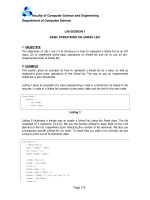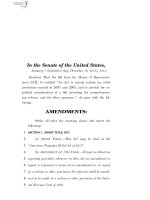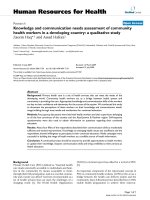TELHEALTH GUIDANCE JANUARY 1 2024 DEPARTMENT OF COMMUNITY HEALTH
Bạn đang xem bản rút gọn của tài liệu. Xem và tải ngay bản đầy đủ của tài liệu tại đây (849.22 KB, 85 trang )
Telehealth Guidance
GEORGIA DEPARTMENT OF COMMUNITY HEALTH
DIVISION OF MEDICAID
January 1, 2024
TELHEALTH GUIDANCE JANUARY 1 2024 DEPARTMENT OF COMMUNITY HEALTH
1
Policy Revisions Record
Telehealth Guidance 2024
REVISI SECTION REVISION DESCRIPTION REVISI CITATI
ON ON ON
DAT TYPE (Revisio
E
A=Add n
Jan. 1, ed require
2019 D=Delet
Jan. 1, ed d by
2018 M=Modif Regulati
Oct. 1 ied
2018 on,
April 1, Page 6 Clarification verbiage added in M Legislati
2019 on, etc.)
July 1, Coverage section in # 1.
2019 Revised CPT Code description M N/A
July 1, N/A
2019 Added Audiology Codes and language A N/A
July 1, related to
2019 Behavioral Health Services N/A
July 1, (Telemental Health)
2019 Added other forms of Telehealth and A Y
Janua respective Article 1
ry 1, regulations and codes pertaining
2020 thereof of
A Chapter
Janua Added Telehealth/Telehealth 24
ry 1, of Title
2020 services for Autism Spectrum 33
O.C.G.A
Disorders, Physicians, .
Online Prescribing D
Y
Physician Services A Article 1
Community Behavioral Health and M of
Rehabilitation Chapter
Addition of Asynchronous service M 24
of Title
definition
License to practice medicine A
obtained through the Inter-state
Compact will be issued by the
State’s Medical Composite Board.
TELHEALTH GUIDANCE JANUARY 1 2024 DEPARTMENT OF COMMUNITY HEALTH
2
April 1, Clarification of Telemedicine 33
2020 Codes as it relates to Public O.C.G.A
Health Emergency .
A
TELHEALTH GUIDANCE JANUARY 1 2024 DEPARTMENT OF COMMUNITY HEALTH
3
Janua Change document to reflect new M
ry 1,
2021 fiscal intermediary from DXE
July 1
2021 Technology to Gainwell
July 1 Technologies D
2021 Deleted WellCare from Telemedicine
Guidance
Janua
ry 1 Added GA Families Appendix A
2022
Janua Deleted Attestation information from D
ry 1 page 15
2022
April 1 Added additional language under A
2022
Billing and Payment for professional
April 1
2022 services furnished via telehealth
Janua Deleted dental code D9999 and D
ry 1
2023 Added dental code D0140
July 1
2023 Added POS 10 A
Added CPT Modifier 93 A
Updates to Community Behavioral M
Health and Rehabilitation Services
Section
TELHEALTH GUIDANCE JANUARY 1 2024 DEPARTMENT OF COMMUNITY HEALTH
4
Table of Contents
Policy Revisions Record of Telehealth Guidance.......................... 2
Program Overview........................................................................ 4
Service Definitions........................................................................ 5
Interstate Medical Licensure Compact (IMLC) ..............................6
Billing and Payment for professional services furnished via telehealth……….7
Billing and Payment for the originating site facility fee....................8
Documentation .............................................................................9
Covered Telehealth Service Modalities.........................................9
Authorizations ............................................................................ 11
Telehealth Reimbursement for Ambulance Providers ................. 12
Autism Spectrum Disorders (ASD)Services ................................14
Community Behavioral Health and Rehabilitation Services ......... 19
Teledentistry............................................................................... 38
Telehealth and Federally Qualified Health Center (FQHC/Rural Health Clinic (RHC)…….40
Telehealth and Dialysis Services ................................................ 42
Nursing Facility Specialized Services.......................................... 44
Telehealth and School Based Settings ....................................... 49
Telehealth and Physician Services ............................................. 53
Appendix A ................................................................................. 55
GA Families Appendix ................................................................ 61
TELHEALTH GUIDANCE JANUARY 1 2024 DEPARTMENT OF COMMUNITY HEALTH
5
Program Overview
The Department of Community Health (DCH) Telehealth and
Telehealth policies are slated to improve and increase access and
efficiency to health care services by enabling medical services to be
delivered via telehealth methods in Georgia. Telehealth services are
not an expansion of Georgia Medicaid covered services but, an
option for the delivery of covered services. Telehealth will allow
DCH to meet the needs of members and providers, while complying
with all applicable Federal and State statutes and regulations. The
quality of health care services delivered must be maintained
regardless of the mode of delivery.
Telehealth is the use of medical information exchange from one site
to another via electronic communications to improve patient’s health
status. It is the use of two-way, real time interactive communication
equipment to exchange the patient’s information from one site to
another via an electronic communication system. This includes audio
and video communications equipment. Closely associated with
telehealth is the term “telehealth,” which is often used to encompass
a broader definition of remote healthcare that does not always involve
clinical services. Telehealth is the use of telecommunications
technologies for clinical care (telehealth), patient teachings and home
health, health professional education (distance learning),
administrative and program planning, and other diverse aspects of a
health care delivery system.
The intent of our telehealth services policy is to improve access to
essential healthcare services that may not otherwise be available for
Medicaid eligible members. Telehealth is not a separate medical
specialty. Products and services related to telehealth are often part of
a larger investment by health care institutions in either information
technology or the delivery of clinical care. When an enrolled provider,
determines that medical care can be provided via electronic
communication with no loss in the quality or efficacy of the member’s
care, telehealth services can be performed.
An interactive telecommunications system is required as a condition
of payment. The originating site’s system, at a minimum, must have
the capability of allowing the distant site provider to visually examine
the patient’s entire body including body orifices (such as ear canals,
nose, and throat). Depending upon an enrolled provider’s specialty
and scope of practice, the distant provider should also have the
TELHEALTH GUIDANCE JANUARY 1 2024 DEPARTMENT OF COMMUNITY HEALTH
6
capability to hear heart tones and lung sounds clearly (using
stethoscope) if medically necessary and currently within the
provider’s scope of practice. The telecommunication system must be
secure and adequate to protect the confidentiality and integrity of the
information transmitted.
Medicaid covered services are provided via telehealth for eligible
members when the service is medically necessary, the procedure is
individualized, specific, and consistent with symptoms or confirmed
diagnosis of an illness or injury under treatment, and not in excess of
the member’s needs.
TELHEALTH GUIDANCE JANUARY 1 2024 DEPARTMENT OF COMMUNITY HEALTH
7
Service Definitions
Asynchronous or "Store and Forward": Transfer of data from one site
to another through the use of a camera or similar device that records
(stores) an image that is sent (forwarded) via telecommunication to
another site for consultation. Asynchronous communication does not
include telephone calls, images transmitted via fax machines and text
messages without visualization of the patient (electronic mail)
The sending of x-rays, computerized tomography scans, or magnetic
resonance images are common store and forward applications. The
original image may be recorded or forwarded in digital or analog
format and may include video ‘clips’ such as ultrasound examinations,
where the series of images that are sent may show full motion when
reviewed at the receiving location.
Distant Site The telehealth site where the practitioner/provider is
legally allowed to practice in Georgia while providing health care
services.
Practitioners at the distant site may furnish and receive payment for
covered telehealth services provided that such services are acting
within the scope of practice of such health care practitioner or
professional, within the guidelines of applicable Medicaid policy for
service rendered and in accordance with the provisions of the
Georgia State Code Section 43-34-31.
Originating Site For members receiving Telehealth or Telehealth
services the originating site is the location where the member will
receive services through a telecommunications system.
Telehealth is a broad definition of remote healthcare that does not
always involve clinical services. Telehealth can be used in
telecommunications technologies for patient education, home
health, professional health education and training, administrative
and program planning, and other diverse aspects of a health care
delivery system.
Telehealth Involves the use of two-way, real time interactive
communication equipment to exchange medical/clinical information
between a healthcare practitioner and the member from one site to
another via a secure electronic communication system. This includes
audio and video communications equipment designed to facilitate
delivery of healthcare services in a face- to-face interactive, though
TELHEALTH GUIDANCE JANUARY 1 2024 DEPARTMENT OF COMMUNITY HEALTH
8
distant, engagement.
TeleMental Health is a term defined by Ga. Comp. R. & Regs. R.
135-11-01. and is applicable only to Licensed Social Workers,
Professional Counselors and Marriage & Family Therapists when
either 1) practicing telehealth as defined above, or 2) providing
telephonic intervention when allowable via DCH/DBHDD guidelines).
Per this rule and regulation, there are specific practice guidelines and
mandatory training pertaining to what is identified as TeleMental
Health. Providers shall adhere to these rules and regulations when
TeleMental Health is provided by one of these named practitioners.
Synchronous services that are occurring in “real-time”, as
demonstrable in two-way consult between a member in concert with
their practitioner/provider and another practitioner/provider at a
distant site.
TELHEALTH GUIDANCE JANUARY 1 2024 DEPARTMENT OF COMMUNITY HEALTH
9
Security and Confidentiality:
In compliance with all applicable Federal and State statutes and
regulations, providers of the CBHRS program are permitted to
incorporate usage of Telehealth for certain services they provide.
The goal for enabling telehealth methods is to improve and increase
access and efficiency of behavioral health service delivery to Georgia
Medicaid members. Appropriate use of Telehealth shall always
consider its secure and confidential use. Special considerations in the
use of electronic-facilitated treatment must include informed consent
of the individual served, authorization through the process of
Individualized Recovery Plans, educational components in
assessment and service delivery which indicates ongoing agreement
with the treatment method and under what circumstances electronic
communications may and may not be used.
Telehealth Services must be HIPAA compliant and in accordance with
Safety and Privacy regulations. All transactions must utilize an
acceptable method of encryption adequate to protect the
confidentiality and integrity of the transmitted information.
Transmissions must employ acceptable authentication and
identification procedures by both the sender and the receiver. All
interactive video telecommunications must comply with HIPAA patient
privacy regulations at the site where the member is located, the site
where the consulting provider is located and in the transmission
process. All communications must be on a secure network in
compliance with HIPAA Encryption (Encryption is the conversion of
plaintext into cipher text using a key to make the conversion) and
Redundancy requirements.
Telehealth- Interstate Medical Licensure Compact
DCH is committed to providing all our stakeholders with the safest
environment possible as well as access to qualified healthcare
providers. The Interstate Medical Licensure Compact (ILMC) offers an
expedited licensing process for physicians that are interested in
practicing medicine in the state of Georgia yet are licensed within
another state. The Compact was created with the goal of expanding
access to health care, especially to those in rural and underserved
areas of the state, and to facilitate the use of telehealth technologies in
the delivery of health care.
Licensure Requirements DEPARTMENT OF COMMUNITY HEALTH
TELHEALTH GUIDANCE JANUARY 1 2024
10
The Georgia Composite Medical Board is authorized to administer
the compact in this state. Under the compact, physicians must meet
certain requirements, including: possess a full and unrestricted
license to practice medicine in a Compact state; possess specialty
certification or be in possession of a time unlimited specialty
certificate; have no discipline on any state medical license; have no
discipline related to controlled substance; not be under investigation
by any licensing or law enforcement agency; have passed the
USMLE or COMLEX within three attempts; and have successfully
completed a graduate medical education (GME) program.
License to practice medicine obtained through this compact will
be issued by the State’s Medical Composite Board.
A physician will apply for expedited licensure by designating a
member state as the state of principal licensure and select Georgia
to which the medical license is desired. The state of principal
licensure will then verify the physician’s eligibility and provide
credential information to the Interstate Commission. The
Commission will then collect the applicable fees and transmit the
physician’s information and licensure fees to the additional states.
Upon receipt in the additional states, the physician will be granted a
license.
TELHEALTH GUIDANCE JANUARY 1 2024 DEPARTMENT OF COMMUNITY HEALTH
11
Additional information will be housed with the Georgia Composite Medical Board.
Billing and payment for professional services furnished via telehealth
Submit claims for telehealth services using the appropriate CPT or
HCPCS code for the professional service. The GT modifier is
required as applicable, and/or the use of either POS 02 or POS 10.
POS 02 will indicate Telehealth services that were utilized at a
location other than at the patient’s home. The GQ modifier is still
required as applicable. By coding and billing with the covered
telehealth procedure code, you are certifying that the member was
present at an eligible originating site when you furnished the
telehealth service. Telehealth services provided by the Distant Site
providers must also bill with the appropriate CPT and/or HCPS code
with the POS code 02 for timely payment. POS 10 will indicate
Telehealth services were provided in the patient’s home.
Providers may not bill for services or charge a fee for missed
appointments. Cost associated with the use of technology or data
transmission are not covered under Medicaid and cannot be charged
to the member.
CPT modifier ‘‘93’’ can be appended to claim lines, as appropriate,
for services furnished using audio- only communications technology.
Billing and payment for the originating site facility fee
Originating sites are paid an originating site facility fee for telehealth
services as described by HCPCS code Q3014 with a payment of
$20.52. Hospitals are eligible to receive reimbursement for a facility
fee for telehealth when operating as the originating site. Claims must
be submitted with revenue code 780 (telehealth) and type of bill 131.
There is no separate reimbursement for telehealth servics when
performed during an inpatient stay, outpatient clinic or emergency
room visit or outpatient surgery, as these are all-inclusive payments.
Coverage Requirements
To provide coverage of medically necessary services provided
using telecommunication systems the following requirements
must be met:
TELHEALTH GUIDANCE JANUARY 1 2024 DEPARTMENT OF COMMUNITY HEALTH
12
1. The referring provider must be enrolled in GA Medicaid and
comply with policy and procedures as outlined in applicable
Georgia Medicaid manuals.
2. The member must be present and participating in the visit.
3. The referring health care practitioner must obtain written
consent from the eligible Georgia Medicaid member prior to
rendering service. The consent must state that the member
agrees to participate in the telehealth-based service. Copies
of this form (refer to Appendix A) should be in the medical
record of both the originating and distant site providers. The
consent form must include a description of the risks, benefits
and consequences of telehealth and be included in the
member’s medical record. Providers may utilize a consent
form other than the one attached to this guide; however, it
must, at a minimum, contain the same requirements,
standards
TELHEALTH GUIDANCE JANUARY 1 2024 DEPARTMENT OF COMMUNITY HEALTH
13
and information listed on the member consent form in Appendix A.
4. The referring provider must be the member’s attending
physician, practitioner, or provider in charge of their care.
The request must be documented in the member’s record.
The physician or practitioner providing the referral must
provide pertinen medical information and/or records to the
distant site provider via a secure transmission.
Notwithstanding the foregoing, referrals for evaluation of
physical, mental, or sexual abuse may be made by an
appropriate agency or group, including but not limited to,
law enforcement or social services agenci
TELHEALTH GUIDANCE JANUARY 1 2024 DEPARTMENT OF COMMUNITY HEALTH
14
5. The referring provider must be requesting the opinion,
advice, or service of another provider for a specific
medical problem, illness or injury.
6. The consulting provider must be an enrolled provider in
Medicaid in the state of Georgia and must document all
findings and recommendations in writing, in the format
normally used for recording services in the member’s
medical records. Both the originating site and distant site
must document and maintain the member’s medical
records. The report from the distant site provider may be
faxed to the originating provider. Additionally, all electronic
documentation must be available for review by the Georgia
Department of Community Health, Medicaid Division,
Division of Program Integrity, and all other applicable
divisions of the department.
7. All telehealth activities must comply with the requirements
of the Health Insurance Portability and Accountability Act
of 1996 (HIPAA): Standards for Privacy of individual
identifiable health information and all other applicable state
and federal laws and regulations.
8. All services that require prior approval must be prior
approved. The provider at the distant site must obtain prior
approval when services require prior approval.
9. If the member is a minor child, a parent/guardian must
present the child for telehealth services and sign the consent
form unless otherwise exempted by state or federal law. The
parent/guardian need not attend the telehealth session
unless attendance is therapeutically appropriate.
10. The member retains the right to withdraw at any time.
11. All existing confidentiality protections and HIPAA guidelines apply.
12. The member has access to all transmitted medical
information, except for live interactive video (if there is
no stored data of the encounter).
13. There will be no dissemination of any member images or
information to other entities without written consent from the
member.
Documentation Requirements
The appropriate medical documentation must appear in the
member’s medical record to justify medical necessity for the level of
service reimbursed. The record must reflect the level of service billed
and must be legible. Documentation must be maintained at both the
originating and distant sites to substantiate the services provided.
Services must be clearly and separately identified in the member’s
medical record. Documentation must indicate the services were
TELHEALTH GUIDANCE JANUARY 1 2024 DEPARTMENT OF COMMUNITY HEALTH
15
rendered via telehealth and the location of the originating and distant
sites. All other Georgia Medicaid documentation guidelines apply to
services rendered via telehealth. Examples include but are not limited
to: chart notes, start and stop times, date of visits, provider’s
signature, service provider’s credentials, signed member consent
form, and physician findings, diagnosis, illness, prescribed treatment,
and so forth.
Covered Telehealth Service Delivery Modalities
• Interactive audio and video telecommunications must be
used, permitting real time communications between the
distant site provider or practitioner and the member.
TELHEALTH GUIDANCE JANUARY 1 2024 DEPARTMENT OF COMMUNITY HEALTH
16
• All transactions must utilize an acceptable method of encryption
adequate to protect the confidentiality and integrity of the
transmission information.
• Transmissions must employ acceptable authentication and
identification procedures by both the sender and the receiver.
• All interactive video telecommunications must comply with
HIPAA patient privacy regulations at the site where the
member is located, the site where the consulting provider is
located and in the transmission process.
• All communications must be on a secure network in compliance
with HIPAA Encryption and Redundancy requirements.
Encryption is the conversion of plaintext into cipher text using a
key to make the conversion.
Non-covered Services Modalities
• Telephone conversations.
• Electronic mail messages.
• Facsimile.
• Services rendered via a webcam or internet-based
technologies (i.e., Skype, Tango, etc.) that are not part of a
secured network and do not meet HIPAA encryption
compliance.
• Video cell phone interactions.
• The cost of telehealth equipment and transmission.
• Failed or unsuccessful transmissions.
TELHEALTH GUIDANCE JANUARY 1 2024 DEPARTMENT OF COMMUNITY HEALTH
17
Authorizations
This guidance is written in accordance with the following
Federal and State rules and regulations in addition to current
specific Department policy manuals.
➢ Georgia Secretary of States Rules and Regulations 135-11-01 TeleMental Health
➢ State Plan Amendment 15-0008 Telehealth and Telehealth Services
➢ State Plan Amendment 15-0012 Transportation Facility Sites
➢ State Plan Amendment, 17-0002 Community Behavioral Health Rehabilitation Services
➢ Part II Policies and Procedures for Federally Qualified Health
Center Services and Rural Health Clinic Services Section 970
➢ Part II Policies and Procedures for Dentistry Services
➢ Part II Policies and Procedures for Children’s Intervention School Services Section 602.5
➢ Part II Policies and Procedures for Community Behavioral
Health and Rehabilitation Services Appendices G and O
➢ Part II Policies and Procedures Manual for Autism Spectrum Disorder (ASD) Services
The state understands that there may be areas within the above
referenced documents that differ in use of terminology.
Additionally, if this guidance is found to conflict with state, federal,
regulatory, or scope of service guidance, please apply the more
stringent guidance.
State’s Response during State and National Emergencies
The guidance contained within this document relates to services rendered and
billed during normal circumstances. In the event of an officially declared National
or State emergency, guidance may be modified to address members’ and
providers’ needs. Providers are asked to refer to the most current Banner
Messages, DCH website (dch.georgia.gov) and Providers Notices as to any
policy updates.
Services that will be moving back to traditional forms of services are Adult Day
Health and performing initial assessments via telehealth. Those services have
until November to begin to move back to traditional plans of care. The 90-
calendar day transition period with respect to telehealth will expire at 11:59 p.m.
on August 9, 2023. In reference to the use of non-HIPAA compliant modalities
to render services. Providers should be doing the following:
A. Verify that they are using a HIPAA -compliant telehealth platform that
securely handles/transmits protected health information (PHI), and
ensure they have a proper contract in place with any vendor that
handles PHI.
B. Review their workflows and update practices that are not in line with
TELHEALTH GUIDANCE JANUARY 1 2024 DEPARTMENT OF COMMUNITY HEALTH
18
HIPAA requirements, such as conducting telehealth visits on a mobile
device. Audio-only encounters must be conducted using HIPAA
requirements, such as conducting telehealth visits on a mobile device.
Audio-only encounters must be conducted using HIPAA-compliant
technology. Services provided using a traditional landline are not
subject to the HIPAA Security Rule because they do not electronically
transmit information. However, phones that use electronic
communication technologies, such as Voice over Internet Protocol
(VoIP), are subject to HIPAA requirements.
TELHEALTH GUIDANCE JANUARY 1 2024 DEPARTMENT OF COMMUNITY HEALTH
19
Telehealth Reimbursement for Ambulance Providers
TELHEALTH GUIDANCE JANUARY 1 2024 DEPARTMENT OF COMMUNITY HEALTH
20









